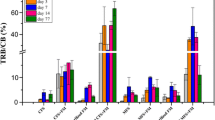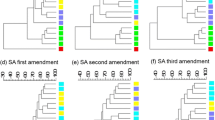Abstract
Background
Tetracycline is a widely used antibiotic in animal production. Significant amounts of the substance reach the soil via feces, urine and manure application. As tetracycline is a persistent compound with antibacterial activity, its presence in soil may have undesired direct and indirect effects. These have been investigated so far focusing on effects on selected microbial functions.
Objectives
The aim of the present study was to obtain comprehensive information on potential effects of tetracycline on the soil microflora under environmentally relevant conditions. The investigations included function and structure of the microbial biocoenosis and the distribution of resistance genes.
Methods
Pig manure rich in tetracycline resistance genes was applied to a sandy soil. This soil as well as an unamended soil were additionally treated with several concentrations of tetracycline. The spiked soils were incubated in outdoor lysimeters for several months. Substrate induced respiration, PLFAs, ten selected resistance genes, and the concentrations of tetracycline were determined.
Results
The test concentrations, though far exceeding environmental relevance, caused only small effects. An establishment of resistance could not be detected. Applied resistance genes were not detectable at the end of the study even in the presence of added tetracycline.
Conclusion
Due to the high sorption capacity of the antibiotic, environmentally relevant concentrations of tetracycline do not seem to cause undesired effects on the soil microflora.
Similar content being viewed by others
References
Alef K, Kleiner D (1989): Rapid and sensitive determination of microbial activity in soils and in soil aggregates by dimethvlsulfoxide reduction. Biol Fertil Soils 8, 349–355
Aminov RI, Garrigues-Jeanjean N, Mackie RI (2001): Molecular ecology of tetracycline resistance: development and validation of primers for detection of tetracycline resistance genes encoding ribosomal protection proteins. Appl Environ Microbiol 67, 22–32
Backhaus T, Froehner K, Altenburger R, Grimme LH (1997): Toxicity testing withVibrio fischeri: a comparison between the long term (24 h) and the short term (30 min) bioassay. Chemosphere 35, 2925–2938
Backhaus T, Grimme LH (1999): The toxicity of antibiotic agents to the luminescent bacteriumVibrio fischeri. Chemosphere 38, 3291–3301
Chee-Sanford JC, Aminov RI, Krapac IJ, Garrigues-Jeanjean N, Mackie RI (2001): Occurrence and diversity of tetracycline resistance genes in lagoons and groundwater underlying two swine production facilities. Appl Environ Microbiol 67, 1494–1502
Chopra I, Roberts M (2001): Tetracycline antibiotics: mode of action, applications, molecular biology, and epidemiology of bacteria resistance. Microbiol Mol Boil Rev65, 232–260
Commission of the EEC (1992) : Directive 92/18/EEC. Off J EEC L 97, 1-12
Cools D, Merckx R, Vlassak K, Verhaegen J (2001): Survival of E. coli and Enterococcus spp. derived from pig slurry in soils of different texture. Applied Soil Ecology 17, 53–62
Cooper AD, Stubbings GWF, Kelly M, Tarbin JA, Farrington WHH, Shearer G (1998): Improved method for the on-line metal chelate affinity chromatogra-phy-high-performance liquid chromatographic determination of tetracycline antibiotics in animal products. Journal of Chromatography A 812, 321–326
Daane LL, Molina JA, Berry EC, Sadowsky MJ (1996): Influence of earthworm activity on gene transfer fromPseudomonas fluorescence to indigenous soil bacteria. Appl Environ Microbiol 62, 515–521
Dickens HE, Anderson JM (1999): Manipulation of soil microbial community structure in bog and forest soils using chloroform fumigation. Soil Biol Biochem 31, 2049–2058
EN ISO 10712 (1995): Water quality —Pseudomonas putida growth inhibition test (Pseudomonas cell multiplication inhibition test) (ISO 10712:1995)
Franklin TJ, Snow GA (1981): Biochemistry of antimicrobial action, 3nd edition. Chapman and Hall: London, 217 pp.
Frostegård Å, Bååth E, Tunlid A (1993): Shifts in the structure of soil microbial communities in limed forests as revealed by phospholipid fattv acid analysis. Soil Biol Biochem 25 (6) 723–730
Fruend H-C, Schoesser A, Westendorp H (2000): Effects of tetracycline on the soil microflora determined with microtiter plates and respiration measurement. Mitteilungen Dtsch Bodenkundl Gesellsch 93, 244–247
Gotz A, Smalla K (1997): Manure enhances plasmid mobilization and survival inPseudomonas putida introduced into the field soil. Appl Environ Microbiol 63, 1980–1986
Grayston SJ, Griffith GS, Mawdsley JL, Campell CD, Bardgett RD (2001): Accounting for variability in soil microbial communities of temperate upland grassland ecosystems. Soil Biol Biochem 33, 533–551
Guillaume G, Verbrugge D, Chasseur-Libotte M-L, Moens W, Collard J-M (2000): PCR typing of tetracycline resistance determinants (Tet A-E) inSalmonella enterica serotype Hadar and in the microbial community of activated sludges from hospital and urban wastewater treatment facilities in Belgium. FEMS Microbiol Ecol 32, 77–85
Halling-Sorensen B (2001): Inhibition of aerobic growth and nitrification of bacteria in sewage sludge by antibacterial agents. Arch Environ Contam Toxicol 40, 451–460
Hamscher G, Sczesny S, Hoeper H, Nau H (2002): Determination of tetracycline residues in soil fertilised with animal slurry by high-liquid chromatography with electrospray ionization tandem mass spectrometry. Analytical Chemistry 74, 1509–1518
Hamscher G, Sczesny S, Abu-Qare A, Hoeper H, Nau H (2000): Stoffe mit pharmakologischer Wirkung einschließlich hormonell aktiver Substanzen in der Umwelt: Nachweis von Tetracyclinen in güllegedüngten Böden. Dtsch Tierarztl Wschr 107, 293–348
Hoeper H, Kues J, Nau H, Hamscher G (2002): Eintrag und Verbleib von Tierarzneimittelwirkstoffen in Böden. Bodenschutz 4/02, 141–147
Hoffmann A, Thimm T, Dröge M, Moore ERB, Munch JC, Tebbe CC (1998): Intergeneric transfer of conjugative and mobilizable plasmids harboured byEscherichia coli in the gut of the soil microarthropodFolsomia Candida (collembola). Appl Environ Microbiol 64, 2652–2659
Hund-Rinke K, Kördel W, Hennecke D, Eisenträger A, Heiden St (2002): Bioassays for the ecotoxicological and genotoxicological assessment of contaminated soils. Part I: Ecotoxicological and genotoxicological tests with aqueous soil extracts. JSS — J Soils & Sediments 2(1) 43–50
ISO/DIS 15685 (2001): Soil quality — Determination of potential nitrification — Rapid test by ammonium oxidation
ISO/DIS 17155 (2001): Soil quality — Determination of abundance and activity of soil microflora using respiration curves
Jensen LB, Baloda S, Boye M, Aarestrup FM (2001): Antimicrobial resistance among Pseudomonas spp. and the Bacillus cereus group isolated from Danish agricultural soil. Environment International 26, 581–587
Lilley AK, Bailey MJ (997): The acquisition of indigenous plasmids by genetically marked Pseudomonad population colonizing the sugar beet phyto-sphere is related to local environmental conditions. Adv Appl Microbiol 63, 1577–1583
Rabolle M, Spliid NH (2000): Sorption and mobility of metronidazole, olaquindox, oxytetracycline and tylosin in soil. Chemosphere 40 (7) 715–722
Schnappinger D, Hillen W (1996): Tetracyclines: antibiotic action, uptake, and resistance mechanisms. Arch Microbiol 165 (6) 359–369
Schnabel EL, Jones AL (1999): Distribution of Tetracycline resistance genes and transposons among phylloplane bacteria in Michigan apple orchards. Appl Environ Microbiol65, 4898–4907
Sczesny S (2001): Analytik von Tetracyclinen in Umwelt- und Lebensmittel-proben mittels selektiver Extraktionsverfahren und sensitivem Nachweis durch HPLC gekoppelt mit mikrobiologischem Assay und Tandem-Massenspektrometrie. Dissertation. Tierärztliche Hochschule Hannover
Smit E, Wolters A, van Elsas JD (1998): Self-transmissible mercury resistance plasmids with gene-mobilizing capacity in soil bacterial populations: Influence of wheat roots and mercury addition. Appl Environ Microbiol 64, 1210–1219
Thimm T, Hoffman A, Fritz I, Tebbe CC (2001): Contribution of the earthwormLumbricus rubellus (Annelida, Oligochaeta) to the establishment of plasmids in soil bacterial communities. Microbiol Ecol 41, 341–351
Tolls J (2001): Sorption of veterinary pharmaceuticals in soils: a review. Environmental Science & Technology35, 3397–3406
Winckler Ch, Grafe A (2001): Use of veterinary products in animal production. Evidence for tetracycline in pig slurry. JSS — J Soils & Sediments 1, 66–70
Author information
Authors and Affiliations
Corresponding author
Rights and permissions
About this article
Cite this article
Hund-Rinke, K., Simon, M. & Lukow, T. Effects of tetracycline on the soil microflora: function, diversity, resistance. J Soils & Sediments 4, 11–16 (2004). https://doi.org/10.1007/BF02990823
Received:
Accepted:
Issue Date:
DOI: https://doi.org/10.1007/BF02990823




